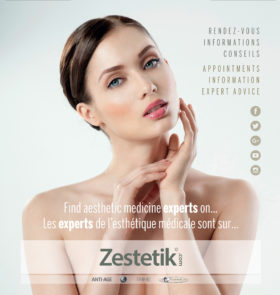By Doctor Sabine Zenker
Facial aging is a complex process affecting different areas and structures of the face in various ways.

This article does focus on the most common problems our patients do complain about and present in the doctor`s consultation and it outlines a science-based, indication-specific therapeutic concept representative for esthetic dermatology.
The age-related three-dimensional facial changes
Even though facial aging starts at the surface by showing signs of aging on the skin, the aging process goes far beyond and finally involves all facial structures such as the muscles, retaining ligaments, fat pads and finally the bony structures. Predominantly and for a youthful and appealing look, the architecture and position of the fat pads is pivotal. But over time, the facial fat pads get redistributed, they do atrophy and get separated (1-6). Further to this, a remarkable bony resorption takes place and doesn`t give the needed structural support (7-9). All this results in deflation and sagging of e.g. the midface in a three-dimensional way (10, 11).
Typical indications for filler treatments
Here, very importantly, filler treatments come into play. Any treatment in dermatology and aesthetic dermatology does require an indication-specific treatment approach: Before any treatment, the individual diagnosis has to be made. The typical indications for filler treatments are:
- Wrinkles
Creases, wrinkles and folds are very often and increasingly bothering, especially with the passing of the years as they do very likely give facial expressions an older-looking and possibly negative touch.
- Volume Loss
Further unwanted changes of facial features such as the occurence of shades, furrows and overall sagging are the reason why patients seek for our help: to restore facial proportions to get back facial features they had in the past or to improve anatomical aspects of a face; basically, it`s about to give back a healthy look with natural fullness and soft and smooth transitions.
My treatment concept for wrinkles by filler
In this article, the author presents her concept for the treatment of wrinkles by direct filling with hyaluronic acid (HA) and the stimulation by filler by polycaprolactone (PCL).
For the technique direct filling with hyaluronic acid, typical indications are e.g. forehead lines . Intradermal retrograde placement (“blanching”) by serial-puncture- or the linear-threading- Technique using a sharp needle (30G 1⁄2”) are the typical ways to inject the filler here (12). The author does mix the hyaluronic acid with local anesthetics in a ratio up to 30% (off-label-use!), to basically achieve an optimal integration of the material in the superficial dermis. Never correct each fold over the clinical endpoint. For the author, a controlled filling by using injection systems is the key, as this increases the accuracy of filler placement and dose.
It also reduces side effects such as pain and bruising, which improves the overall aesthetic outcome in especially very superficial injections (13). The result of this direct filling technique with hyaluronic acid lasts –depending on material used and individual conditions- for some months.

The stimulation technique by filler by polycaprolactone is especially suited if an immediate filling is desired as well as additionally a sustainable effect of collagen stimulation starting appr. 3 months after injection (14, 15). (Polycaprolactone is a biodegradable filler material consisting of microparticles of PCL suspended in a gel carrier (carboxy-methyl-cellulose (CMC)). The material is placed using a 25G 11⁄2” blunt tipped cannula subscision-wise in the subdermal level in a fan pattern in a retrograde fashion covering the whole area to be treated; the point of insertion is chosen in a 90° angle and in the middle of the fold. The approximate amount of filer injected is 0.1cc.

My treatment concept for volume loss by filler
The treatment of the 3-D-volume loss will be showcased here by demonstrating techniques for midface. Typical indications here are the sunken-in frontal part of the cheek and the sagged lateral part.
Facial mapping helps to identify the areas to be augmented, the zones of danger and to plan the overall injection strategy as well as to identify the relevant entrypoints.

For the technique volume loss by filler, typically highly visco-elastic hyaluronic acid fillers with a good volumizing capacity (16, 17) or Calcium Hydroxylapatite, CaHA (Radiesse©), a calcium particles based filler (18, 19) are used. Especially Calcium Hydroxylapatite has – according to the author`s long-term clinical experience – a very good and precise shaping capacity. The use of blunt tipped cannulas results in a more atraumatic (18), quicker treatment procedure, especially when the filler needs to be placed over “longer distances” (19-24). For the two indications elaborated here, blunt tipped 25G 11⁄2” cannulas are espacially suited.
The following pictures illustrate typical entry points for this treatment concept, the Cheek-Apex- Entry-Point and the Zygomatic Entry-Point.

The Cheek Apex Entry-Point, entry-point to treat the sunken-in frontal part of the cheeks, is the point around which the frontal projection of the cheek will be reconstituted.

The Zygomatic Arch Entry-Point, entry-point to treat the sagged lateral part of the cheeks, is the starting point from which the lateral lifting will be effected.
The filler material used to showcase the author`s technique here, are the hyaluronic acid Perfectha© Subskin and Calcium Hydroxylapatite (Radiesse©) (mixed with Lidocain 1% in a 20% ratio). As equipment, a blunt tip cannula 25G/38mm is used (Steriglide®).
Sunken-in frontal part cheek
Starting point is the Cheek Apex Entry-Point. The filler is injected in a bolus technique („gunshot- wise“), in a retrograde way and placed supraperiostally; according to the clinical needs, more injections medial and eventually lateral of the first entry-point are performed in a “banana-wise” way. Amount of filler per point is approximately 0.1cc. Augmentation is conducted up to the clinical endpoint.
Sagged lateral part cheek
Starting point is the Zygomatic Arch Entry-Point. The filler is injected in a fanning technique in retrograde fashion starting supraperiostally and ending up subdermally on the most lateral part of the to be injected area. Amount of filler per point is approximately 0.1-0.2cc. Augmentation is conducted up to the clinical endpoint.
Using these two techniques the frontal projection of the cheeks as well as the lateral lifting can be effected in a customized and individual way.

Indication volume loss: treatment volume loss by fillers with Calcium Hydroxylapatite (Radiesse®) 3-D-Analyse Quantificare©

Age related changes such as wrinkles and volume loss can be easily and individually treated by filler. An indication-specific filler treatment approach shows, how versatile fillers are: applying them by using the relevant, appropriate techniques, they can serve for all, filling, stimulating and volumizing.
 Doctor Sabine Zenker
Doctor Sabine Zenker
MD, is specialized in dermatology and dermatological surgery. She is an expert and trainer for non- and micro-invasive procedures in the field of aesthetic dermatology, an active member of scientific boards of leading conferences, conducts clinical trials, publishes articles and is a member of national and international dermatological associations.







